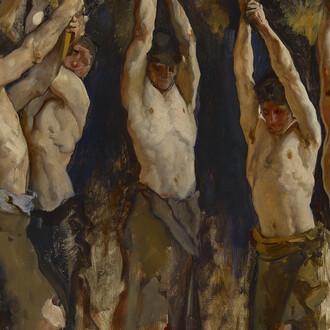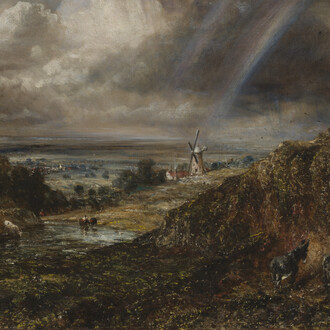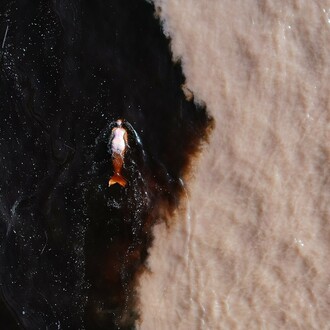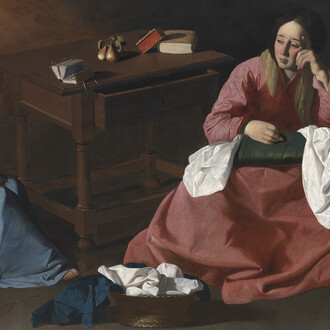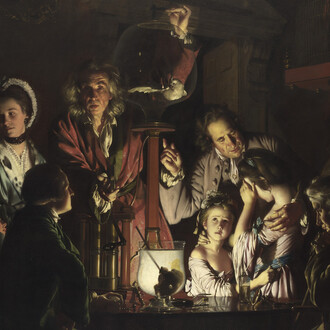Amar Gallery is proud to announce the 1st UK solo exhibition for LGBT expressionist painter Lawrence Calcagno: Redux, featuring paintings and works on paper. The exhibition is transatlantic, with 203 Fine Art USA exhibiting works in their Taos, New Mexico, space, and Amar Gallery exhibiting works in London. This is the first time many of these works have been exhibited in London. Calcagno’s life is nothing short of remarkable, and this exhibition aims to bring a master of art back to the forefront of art history.
Lawrence Calcagno (1913–1993) was an American abstract painter known for his vibrant, textured canvases that reflect both the natural world and internal landscapes. His work is often associated with Abstract Expressionism, though he was somewhat independent from the central figures of the movement. Calcagno’s use of color, brushwork, and depth creates a sense of meditative calm, often suggesting horizons, landscapes, or cosmic environments.
In 1941, at the beginning of World War II, Calcagno joined the United States Army Air Corps, where he served for three years. During his service, he was recognized as an artist. His drawing titled: "Watch in the Night" won first prize in the national Army art contest in the Southwest Regional competition.
Benefiting from the Servicemen’s Readjustment Act of 1944, commonly known as the G.I. Bill, which was passed in the United States to provide various benefits to returning World War II veterans (referred to as G.I.s). The bill was designed to help veterans reintegrate into civilian life by offering financial support for education, housing loans, and unemployment benefits.
By 1947, many veterans were taking full advantage of the educational benefits offered by the G.I. Bill. Specifically, the education provision allowed veterans to attend college or vocational training programs with their tuition, fees, and even living expenses covered. This marked a significant shift in American higher education, as it enabled millions of veterans, including Lawrence Calcagno, to pursue higher education and careers they might not have otherwise had access to.
In Calcagno’s case, the G.I. Bill allowed him to enroll at the California School of Fine Arts in 1947, where he studied under renowned artists like Mark Rothko and Clyfford Still, along with instructors, Edward Corbett and Richard Diebenkorn.
In 1950, he left the California School of Fine Arts for Europe. He went to Paris, France, to study at L’Académie de la Grande Chaumière. Beauford Delaney and Lawrence Calcagno, an unlikely pair, the two became friends and lovers in Paris in the early 1950s and remained close over the next twenty years. At the time of their union, both interracial and homosexual relations were illegal throughout most of the United States. Through Delaney, Calcagno became friends with writers such as James Baldwin and Ralph Ellison.
Calcagno was friends with the African American artist Jack Whitten. In 1964, Calcagno supported Whitten alongside artists Romare Bearden, Jacob Lawrence, and Wayne Thiebaud to secure Whitten a grant for minority artists from the John Hay Whitney Fellowship. Supporting artists of colour was important to Calcagno. In 1965, Calcagno became Andrew Mellon Professor in Painting at Carnegie Mellon University, in Pittsburgh, Pennsylvania, where he stayed until 1968. Calcagno was a fellow at the McDowell and Yaddo artist colonies in the 1960s.
As Time Magazine wrote in 1955, “Calcagno remains emphatically from San Francisco, as demonstrated by his semiabstract paintings, saturated with rich California earth tones and the shifting, fog-ridden horizons of the Pacific Coast.” In 2024, Hyperallergic Magazine wrote, “Although frequently introduced as a student of Mark Rothko and Clyfford Still, abstract expressionist painter Lawrence Calcagno was his own master.”
Lawrence Calcagno was an openly gay artist during a time when being part of the LGBTQ+ community was met with significant social stigma. His identity as a gay man influenced both his personal life and artistic expression, though it wasn’t a central or overt theme in his work. Unlike many artists of the Abstract Expressionist generation, who sometimes grappled with themes of masculinity and power in their art, Calcagno’s work often focused on landscapes and the inner emotional world, providing a space for contemplation and reflection.
Living in the mid-20th century, Calcagno was part of a broader LGBTQ+ community of artists and intellectuals, many of whom were pushing boundaries not just in terms of sexuality, but in art and culture as well. While his sexual orientation was known in his personal circles, it wasn’t a defining element of how he was publicly perceived as an artist.
In later years, the increasing visibility and acceptance of LGBTQ+ artists have led to a greater appreciation of the complexities surrounding the lives of figures like Calcagno. Today, his life and work are often discussed within the broader context of LGBTQ+ contributions to modern art.
Lawrence Calcagno’s artistic journey reflects a unique blend of personal struggle, global influences, and a deep connection to nature. Born on March 23, 1913, in Potrero Hill, San Francisco, Calcagno grew up in a poor Italian-American family. His early years were marked by a series of hardships, including the early death of his father. Despite this, Calcagno’s passion for art persisted, and he took evening classes in painting at the California School of Fine Arts (now the San Francisco Art Institute).
Early influences and World War II
During the Great Depression, Calcagno worked various jobs and eventually joined the Civilian Conservation Corps (CCC). His exposure to the natural landscapes during his time with the CCC deeply influenced his later artistic work. In 1942, he enlisted in the U.S. Army and served during World War II. His experiences during the war, including time spent in North Africa and Europe, left an indelible mark on his worldview and artistic sensibilities.
Education and artistic development
After the war, Calcagno returned to the U.S. and resumed his art education. He studied at the California School of Fine Arts, where he was influenced by artists such as Clyfford Still and Mark Rothko, key figures in the Abstract Expressionist movement. In 1950, Calcagno received a Fulbright Fellowship, allowing him to travel and study art in Europe, particularly in Paris, where he was exposed to a broader range of modernist ideas.
Breakthrough and career
By the 1950s and 1960s, Calcagno began to establish himself as a prominent abstract artist. He developed a distinctive style, blending vibrant color fields with organic forms, and often drawing inspiration from the natural world. His work has been compared to the “abstract landscapes” of American modernist painters, though Calcagno’s art often evokes a sense of both inner and outer exploration.
Calcagno displayed his work across the U.S. and Europe, including at prestigious galleries such as the Whitney Museum of American Art in New York. His works are known for their layered textures and emotional depth, often reflecting both the landscapes of his travels and his inner spiritual quest.
Later years and legacy
Calcagno continued to create and exhibit art until his death in 1993. His works are held in several major collections, including the Museum of Modern Art in New York, the Smithsonian American Art Museum, and the San Francisco Museum of Modern Art. His unique contribution to the abstract movement lies in his deep connection to nature, personal struggle, and an ongoing search for spiritual meaning.
His life and art reflect a constant journey—both literal, in his global travels, and figurative, in his artistic exploration of color, form, and space.










